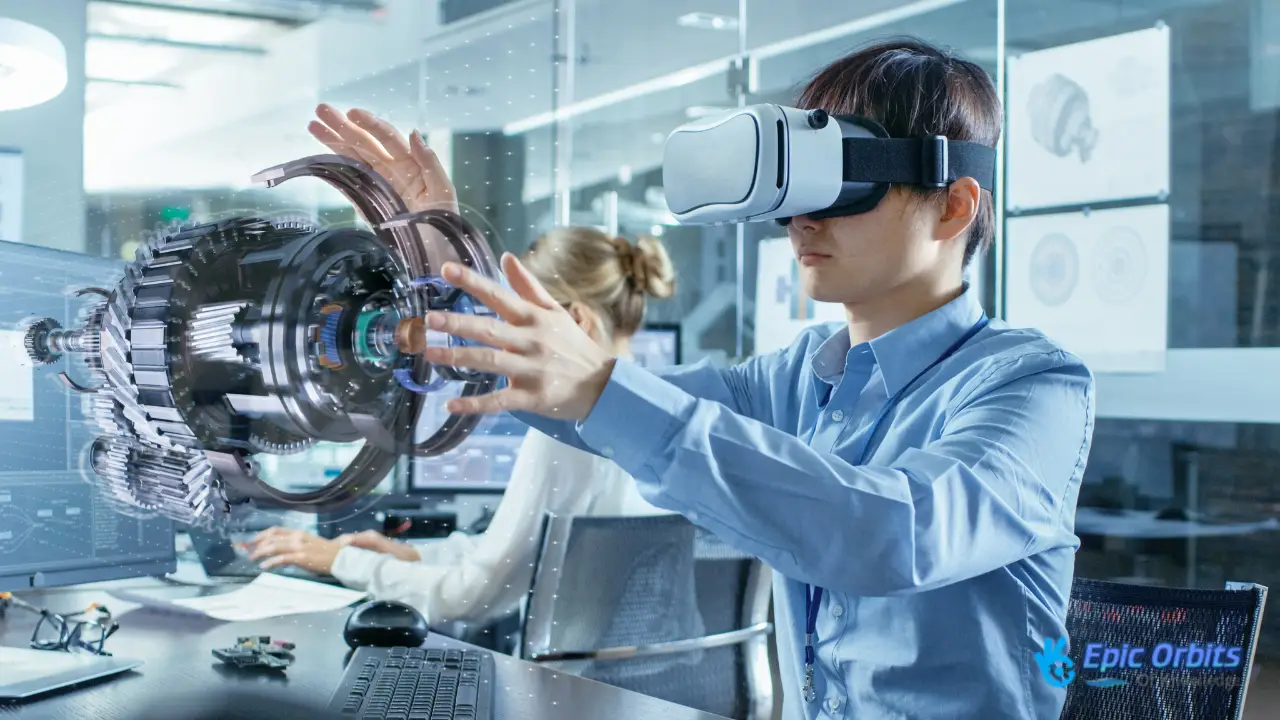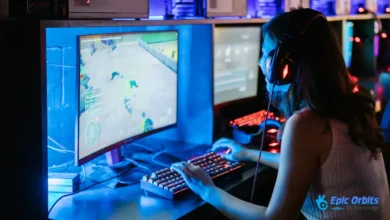Virtual reality immersive technology changing the future
Virtual reality is an advanced technology that allows users to interact with simulated worlds through virtual reality headsets.

Few ideas at a time of rapid technical development have generated as much interest and mystery as virtual reality (VR).
Through the use of specialist VR headsets, this advanced technology lets users interact with painstakingly created virtual settings, therefore transcending the boundaries of the actual world.
As we stand on the cusp of a digital revolution, virtual reality is not just a new kind of entertainment; it’s also a potent instrument changing our view and interaction with the environment.
Fundamentally, virtual reality is a combination of modern technology, software, and human creativity intended to provide experiences as exciting as they are transforming.
Users of a VR helmet are transported into a vivid world where they may investigate exotic locations, interact with lifelike avatars, and participate in adventures beyond the limit of their imagination.
From gaming and entertainment to education, healthcare, and even business training, this technology has found usage in many different fields, showing its versatility and universal attraction.
Virtual reality has the power to transform our learning, communication, and employment in addition to providing simple escape.
By using VR, students in the classroom may immerse themselves in historical events, conduct virtual scientific experiments, or examine challenging concepts in a three-dimensional environment, thereby enhancing their understanding and retention of information.
Virtual reality (VR) is being used by medical professionals for surgical simulations and patient rehabilitation; therefore, they are establishing safe environments in which they might develop their skills. Companies are also increasingly embracing VR for virtual meetings, product displays, and team-building exercises in a worldwide, multinational setting, therefore fostering collaboration and innovation.
But as we explore the field of virtual reality, we must also take ethical and social consequences into account alongside this amazing tool.
Problems such as data privacy, the possibility of addiction, and the consequences of extended immersion in virtual worlds challenge developers, consumers, and legislators equally concerning their respective duties.
A careful conversation about these issues will be essential as we negotiate this unexplored ground to ensure that virtual reality improves rather than subtracts from human experiences.
The many aspects of virtual reality will be discussed in this paper along with its technical roots, several uses, and future consequences.
Understanding the possibilities and constraints of VR will help us to value its contribution in forming a new age of digital interaction and the fascinating opportunities that await.
Join us as we explore the immersive settings of virtual reality and uncover the concepts ready to change our relationship with the digital universe.
How Different Is Virtual Reality from Other Technologies?
Especially virtual reality (VR) offers immersive experiences. This results from virtual reality headgear. It models settings that are either difficult or impossible to observe in actual life. Users therefore get unique, engaging, and immersive experiences unlike anything else.
Virtual reality encounters have complicated psychological foundations. It addresses our brain’s interpretation and processing of the VR. Understanding VR’s effect and developing better VR apps depend on this.
- Immersive nature: entirely computer-generated simulations.
- Users of the virtual environment may interact with it.
- Specialized tools are usually needed for a virtual reality helmet and sometimes other hardware.
One must grasp these elements as well as the psychology behind them. Unlocking VR’s full potential and generating really immersive experiences depend on it.
Virtual and augmented reality technologies offer different experiences and levels of accessibility. VR (Virtual Reality) provides immersive, computer-generated simulations, but requires a specialized headset and hardware to experience fully. AR (Augmented Reality) overlays virtual information onto the real world and is more accessible, often available through standard smartphones without additional equipment.
From Science Fiction to Reality: Virtual Reality’s Evolution
From science fiction to actual fact, virtual reality has evolved significantly. Virtual reality’s concept has been present for years. The first VR headsets, however, were created only in the 1990s.
These early headsets were expensive and somewhat large. Nevertheless, they established the foundation for today’s VR technology.
Crucial turning points in VR’s development are the Headsight and the Sensorama. The 1968 “Sword of Damocles” VR helmet coupled to a computer was the first one. Its visuals were simple and wire-based.
Thanks in great part to well-known companies like Facebook, Google, and Sony, VR is growing right now. Published in 2020, the Oculus Quest 2 claims millions of worldwide sales. As VR technology advances, new uses will quickly emerge.
- Immersive learning events take place in education.
- The treatment of disorders such as phobias, anxiety, and PTSD in healthcare will benefit from VR technology.
- improved entertainment sector gaming experiences.
VR continues to evolve, and we can expect even more amazing content in the future. The future seems bright with increasing VR investment.
Fundamental elements of a virtual reality setup
Developing a fantastic virtual reality experience requires the correct equipment. The key is a virtual reality headset because it provides an interactive and immersive environment. Consider your budget, desired content, level of immersion you want, and headset choice.
You’ll also need a robust computer or console as well as other tools, such as sensors and controllers. Headset costs vary greatly. Top models cost more than $1,000; the least priced tethered models start at $400. Among the most typically picked are the Valve Index, HTC Vive, and Oculus Quest 2.
Following these important considerations will help you choose a virtual reality helmet:
- Look for a high-resolution helmet—say, 1832 x 1920 for each eye.
- A more immersive experience comes from a larger field of view.
- Select a headset with advanced or room-scale tracking.
- Choose a comfortable and simple-to-use headset with controls.
Considering these principles and selecting the right gear will enable you to enjoy wonderful virtual reality. Whether for gaming, movies, or research, a virtual reality helmet offers unmatched immersion and pleasure.
Popular VR headsets vary in price but offer similar resolutions. The Oculus Quest 2 costs $299 and provides a 1832 x 1920 resolution per eye. The HTC Vive, priced at $1,399, offers the same per-eye resolution. The Valve Index, at $999, also delivers 1832 x 1920 per eye, balancing performance and cost for high-quality VR experiences.
Beginning your first virtual reality experience
Starting with virtual reality, you have to arrange your equipment. This covers a computer or console as well as VR headgear. VR headsets are priced between $299 and $999, so there is a suitable option for everyone.
After you have set up your device, it’s time to choose your content. You have options including games, movies, and more. These encounters provide a thorough immersion in other realms.
One excellent start is virtual reality gaming. You may test over 5,000 games from the SteamVR marketplace. Steam’s 32% annual sales surge for VR gaming indicates its rising appeal.
Start by merely doing as advised by the manufacturer. This guarantees a wonderful and safe encounter.
Popular VR gaming choices include Meta Quest 2 and Meta Quest 3. They function both as PCVR and independent devices. The Meta Quest software ecosystem has shown popularity by selling goods valued at about $2 billion.
Virtual reality has something to offer regardless of your interests—gaming or simply seeking novel experiences.
Realizing Virtual Reality Uses in Many Fields
Virtual reality is expanding rapidly. It has use in many spheres. Virtual reality has one major advantage: it provides immersive experiences. Users thus become more involved and participatory.
Healthcare uses virtual reality for treatment, training, and instruction. For instance, chronic pain treatment is accomplished using FDA-approved EaseVRx.
The use of virtual reality makes learning in school entertaining and participatory. Pupils may utilize virtual laboratories and go on virtual field excursions. They learn better and like it more.
VR finds use outside of the classroom. It also finds use in business training. Businesses such as Walmart and Bank of America utilize it to teach staff members. The tool allows them to remember what they study and to develop their talents.
Allows designers and builders in architecture and other fields to create immersive creations. Customers can visualize and experience the design prior to its construction. It saves money by preventing subsequent expensive adjustments.
Serves purposes beyond just building design. It also finds use in product design and development. Manufacturers such as Honda and BMW create and test goods using it. The tool improves the design process and helps to lower the need for actual prototypes.
In the healthcare industry, virtual reality (VR) is used for medical training, patient treatment, and therapy. This technology can lead to improved patient outcomes and reduced costs.
In education, VR enables interactive and immersive learning experiences, which help improve student engagement and increase knowledge retention.
For architecture and design, VR allows for immersive and interactive designs, reducing the need for costly changes and improving the overall design process.
The Gaming Revolution: VR Changing Entertainment
Virtual reality games are transforming entertainment. Virtual reality games offer events beyond our imagination. The estimated valuation of the worldwide virtual reality industry in 2021 is $6.87 billion. This evidence indicates that VR technology is not going to fade.
Gaming in virtual reality has various advantages. It gives games a more dynamic and captivating quality. Some important figures indicate its influence on gaming:
- By 2023, almost thirty percent of players have experimented with VR technologies.
- By 2025, the VR gaming industry is predicted to reach $22.9 billion.
- More than 60% of VR gamers believe that immersive gaming is superior to traditional formats.
Entertainment will find new applications as VR technology improves. Immersion experiences have many opportunities. I am excited about the future possibilities that virtual reality gaming offers.
In 2021, the virtual reality (VR) market was valued at $6.87 billion, experiencing a compound annual growth rate (CAGR) of 30.2%. By 2025, the market is projected to reach $22.9 billion, with VR expected to contribute to a 25% increase in productivity.
Corporate Use Cases and Applications
Growing rapidly and beyond just entertainment is the virtual reality sector. These days, it finds application in many spheres of business, including product design, training, and teamwork. For instance, Lowe’s saw a 36% greater memory rate among consumers who utilized virtual reality than those viewing YouTube videos.
Virtual reality applications are also transforming sectors like architecture, education, and healthcare. In the medical field, it guides physicians toward difficult treatments and operations. VR helps schools make learning more interesting and successful.
VR has several advantages for business. It increases training, collaboration, and production as well as performance. For technical instruction, Tulsa Welding School, for example, uses VR simulators. VR also helps consumers see items in great detail, therefore guiding their decisions.
Product design and prototyping also depend much on VR. It speeds up and cheapens testing ideas and prototypes. Future applications of VR technology should be far more varied.
The Technical View: How Virtual Reality Really Functions
Virtual reality (VR) technologies have advanced greatly. Immersion experiences are created by its technological elements firstly. Every VR headset has haptic feedback, motion tracking, and display technologies. These cooperate to create a lifelike environment.
The helmet sits at VR’s core. Tracking your motions, it displays the virtual environment. The aim is a genuine, seamless experience with a 120 FPS frame rate to prevent sickness and uncertainty.
Regarding VR’s tech side, several noteworthy numbers abound:
- Headsets with six degrees of freedom provide for autonomous movement, hence improving the immersive experience.
- Modern VR headsets improve directionality and realism by use of spatial audio technologies.
- Tracking gloves and haptic feedback devices are progressively supplanting conventional VR control techniques.
Advanced and immersive experiences will abound as VR technology develops. VR is here to stay, given the worldwide market size for VR and AR predicted to reach $18.8 billion. VR is worth investigating regardless of your interests—gaming, design, or just enjoying technology.
VR headsets are devices that provide an immersive virtual experience. Motion tracking technology monitors the user’s movements to create a more interactive environment. Haptic feedback systems simulate the sense of touch and feeling, enhancing the realism of virtual experiences.
Typical Problems and Fixes in VR Application
Though it has obstacles as well, virtual reality is transforming numerous sectors. Among the major problems is motion sickness. This occurs when your body receives conflicting signals from the virtual world and actual reality.
Additional issues include eye strain. It happens from too long of staring at displays. Another challenge might be VR gear and content’s price. Many businesses, nevertheless, are working to make VR more accessible and reasonably priced.
These are some typical VR problems along with their solutions:
- Using cozy VR headsets and taking breaks will help with motion sickness.
- Following the 20-20-20 rule and adjusting display settings help to lower eye strain.
- Cost: By selecting reasonably priced VR headsets and creating low-cost VR programs, one may cut the expenses.
VR may provide incredible experiences despite these challenges. It may advance enjoyment, healthcare, and education. More inventive and reasonably priced VR applications will show as VR technologies advance.
One common challenge in using virtual reality (VR) is motion sickness, which can be alleviated by taking regular breaks and using comfortable VR headsets. Eye strain is another issue, and it can be reduced by following the 20-20-20 rule and adjusting display settings appropriately. The high cost of VR technology can be addressed by investing in affordable VR headsets and developing cost-effective VR applications.
The Development of Virtual Reality Towards Future
Virtual reality stands at a major turning point. Innovations and fresh technology will transform the game. We eagerly anticipate the expansion and application of virtual reality in various fields.
Future VR will depend much on artificial intelligence and machine learning. Additionally on the increase are VR in healthcare and education and standalone headsets. Virtual reality’s influence on our lives is significant given the millions of headsets sold.
VR will find fresh use as it develops. Already, colleges and institutions use it in their courses. Medical experts also use it for practice and training.
Virtual reality’s future is fascinating and quickly evolving. New technologies arriving include user-centric design and high-resolution screens. These will make using VR more enjoyable and easily available.
The industry for VR is predicted to expand somewhat extensively. From $829 million in 2025 to $4.26 billion by 2027, VR commercial equipment is expected to have increasing value. More businesses utilizing virtual reality—including entertainment, healthcare, and education—will help to drive this increase.
Safety and Health Issues Affecting VR Users
Our experience of events is being altered by VR. Still, one should consider its consequences on health and safety. Extended VR headgear usage may lead to motion sickness, eye strain, and isolation. VR should be used sensibly and healthily.
Important actions include not using VR too much, not performing other activities while using it, and taking pauses. Watch children, too, as they utilize VR. They could be more prone to experiencing seizures or other negative consequences.
These guidelines help you to use VR safely:
- For every 30 minutes of VR usage, take at least ten- to fifteen-minute breaks.
- Children under twenty should limit VR usage to fifteen minutes.
- Until all symptoms have gone away, refrain from operating or driving machines following VR usage.
- To stop the spread of infectious diseases, routinely clean the helmet using non-alcoholic antibacterial wipes.
Following these rules and understanding the health and safety concerns of virtual reality can help users have fun while remaining secure.
For children under 13, VR usage is not recommended. Children between 13 and 20 can use VR, but it should be limited to 15 minutes at a time and conducted under adult supervision. For adults, it is advised to take regular breaks and limit overall usage time to ensure comfort and safety.
Conclusion
Fast-evolving virtual reality will affect numerous spheres. By 2027, the global VR market is expected to reach $57.55 billion. An estimated 171 million people will be using VR.
Millions of people find gaming more engaging because VR has already revolutionized it. It is also transforming. Education, healthcare, and various other fields have already adopted VR. VR lessens anxiety, improves learning, and eases pain.
The future seems bright as VR improves and more people can use it. It will provide fresh approaches for working creatively and collaborating, and VR will provide fresh and fascinating new perspectives on the world. ing new perspectives on the world.



